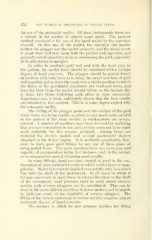Page 530 - My FlipBook
P. 530
252 THE TECHNICAL PROCEDURES IN FILLING TEETH.
the use of the automatic mallet. Of these instruments there are
a variety in the market of almost equal merit. The looorest
method practiced is the use of the hand mallet by the operator
himself. In this use of the mallet, the operator can handle
neither the plugger nor the mallet properly, and the usual result
is great wear and tear upon both the patient and operator, and
generally much imperfect work in condensing the gold, especially
in its adaptation to margins.
In order to condense gold well and with the least pain to
the patient, the mallet force should l)e combined with a certain
degree of hand pressure. The plugger should be placed firmly
in position with such force as to bring the looser portions of gold
well together and to force the tooth into a stable position in which
the fibers of the peridental membrane are rendered tense, and
then the blow from the mallet should follow on the instant this
is done, two blow.s following each other in close succession.
Experience has, I think, sufficiently shown that the best results
are obtained by this method. This is in some degree copied with
the automatic mallet.
The sliding of the plugger point over the surface of the gold
while blows are being rapidly applied, is very much more painful
to the patient if the same results in condensation are accom-
plished. A number of machines have been devised for malleting
that are very convenient in use, and yet they seem not to be much
used, evidently for the reasons assigned. Among these are
included the electric mallet and several mechanical devices
attached to the dental engine. It is perfectly practicable, how-
ever, to make good gold fillings by any one of these plans of
using mallet force. The main questions here are as to ease and
rapidity of manipulation in the first instance, and, in the second,
as to comparative ease of obtaining good results.
In many fillings, hand pressure should be used in the con-
densation of some particular parts to which mallet force is inap-
plicable. Mallet force can be applied successfully only in a direct
line with the shaft of the instrument. In all cases in which it
becomes necessary to apply force in lateral directions to the shaft
of the instrument, hand ])ressure must be used, unless reverse
motion with reverse phiggers can be substituted. This can be
done in the more difficult ])ositions in lower molars and bicuspids
by judicious study of the capability of reverse pluggers. The
filling of tlie incisal anchorage in incisor cavities requires almost
uniformly the use of hand pressure.
The manner in which we now prepare cavities for filling


